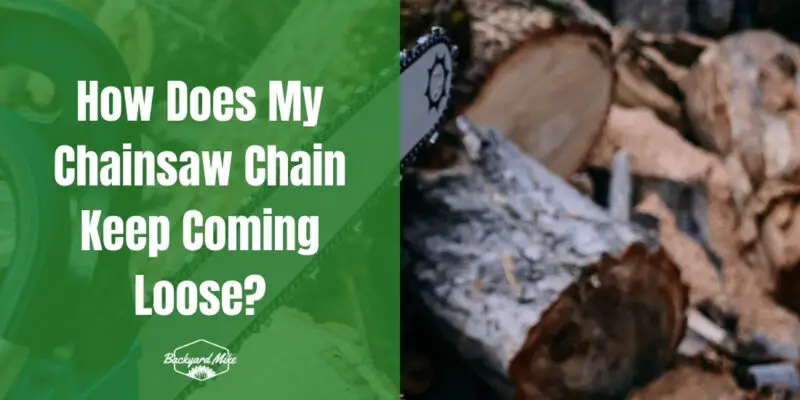Your chainsaw chain keeps coming loose due to several factors like improper tension adjustments, worn sprockets, or a damaged guide bar. Make certain the chain is snug against the bar without over-tightening. Regularly check for wear on the sprocket and compatibility with the chain, and address lubrication to prevent overheating. Practice proper adjustment techniques to minimize errors and inspect mechanical components frequently for common issues. Enhance your skills further to keep your chainsaw in smooth operation.
Key Takeaways
- Incorrect tension adjustment can cause the chainsaw chain to come loose frequently during operation.
- A worn or damaged sprocket can lead to accelerated chain wear, resulting in chain loosening.
- Insufficient lubrication increases friction, contributing to chain stretching and loosening.
- A worn or misaligned guide bar can cause the chain to derail and become loose.
- Faulty or misaligned tensioning systems can prevent the chain from maintaining proper tension.
Understanding Incorrect Tension
Incorrect tension in a chainsaw chain is a common issue that can lead to several operational problems. You'll find that improper tension adjustments can cause the chain to become too loose or too tight on the guide bar. When the tension is incorrect, tension indicators like excessive vibration, noise, or the chain slipping off the bar become apparent. It's important to note that many chainsaws come with anti-vibration systems to help reduce jolting movements during operation. New chains stretch significantly during the break-in period, which can contribute to tension issues. These symptoms not only affect performance but also pose safety risks. To manage this, regularly check and adjust the tension as per the manufacturer's guidelines. Use the tensioning screw to find the right balance; there should be slight play in the chain. Remember, paying attention to these tension adjustments guarantees your chainsaw functions smoothly, making you feel more connected to your tools and tasks.
Identifying Sprocket and Chain Wear
To keep your chainsaw running efficiently, it's essential to recognize signs of sprocket and chain wear.
Sprocket maintenance is often overlooked, but it plays a vital role in your chainsaw's performance. Check for wear marks on your sprocket, replacing it when they reach about 0.5mm. This prevents accelerated chain wear, which can cause your chain to become loose. Regular inspection is crucial for the longevity of your chainsaw, as worn sprockets can lead to significant performance issues.
Confirm chain compatibility with your sprocket to avoid misalignment and excessive friction. Look out for signs like a "clinky" chain, which indicates wear. Regularly use a control gauge to assess the sprocket's condition, especially on spur sprockets.
Don't ignore wear markers on the chain's teeth, as exceeding them can reduce cutting performance. Proper maintenance extends both sprocket and chain life.
Addressing Guide Bar Problems
When addressing guide bar problems, it's essential to understand how a worn groove affects your chainsaw's performance. A worn groove lets the chain move side to side, which can lead to misalignment and unwanted tension issues. Husqvarna chainsaw bars, for example, are designed for demanding conditions and provide low vibration, which can help minimize such problems. Make certain your bar is properly sized for your chain, as this guarantees ideal alignment and tension, preventing premature wear and enhancing safety. Regular inspection of the guide bar for damage and wear is crucial to maintaining safe and efficient chainsaw operation.
Worn Groove Effects
A worn groove on your chainsaw's guide bar can lead to several issues, affecting both performance and safety. It disrupts chain stability, causing the chain to move excessively, which accelerates wear and poses safety risks. Proper chain tension allows for slight downward pull (under 1/4 inch), which helps maintain chain stability during operation. To maintain groove maintenance, regularly inspect the groove depth using a filing gauge, ensuring it matches the chain's specifications. Address chain tension issues promptly, as a loose chain can slip off the bar, a serious hazard. If you notice the chain running roughly, check for worn bar rails and attend to them. Filing or leveling can temporarily fix minor wear, but significant issues call for replacing the guide bar. Regular maintenance, including cleaning, helps prevent premature wear and extends the bar's lifespan.
Bar Sizing Importance
Selecting the correct bar size for your chainsaw is essential for both safety and efficiency. Bar length directly affects cutting efficiency, so choosing the right size guarantees smoother, controlled cuts. If the bar is too short, you'll struggle with larger wood, making your task harder and less safe. Conversely, a bar that's too long might overpower your machine, requiring more skill and effort. For pruning, a short bar suffices, while larger trees demand longer bars. Remember, the bar length should exceed the wood's diameter by at least two inches. This sizing not only enhances safety but also boosts your chainsaw's performance. Always match the bar to the task, confirming your chainsaw's engine power aligns with the bar length for ideal results. Medium-sized chainsaws, with bar lengths of 16-20 inches, are versatile for cutting firewood and trimming medium-sized trees, handling branches and limbs with up to 16 inches in diameter.
Alignment and Tension
Maintaining proper alignment and tension of your chainsaw's guide bar is vital for safe and efficient operation. Start by checking the chain alignment regularly. This helps prevent uneven wear and reduces the risk of your chain loosening during use. Proper positioning of the guide bar is critical, as even slight warpage or damage can disrupt alignment. Remember to always wear gloves when handling the bar and chain for safety. Keep an eye on the tension maintenance by inspecting the calibration of the bar against the chain specifications. Always adjust the tension before and during your work, using the right tools to avoid damaging the mechanism.
Ensuring Proper Lubrication
While maintaining a chainsaw, guaranteeing proper lubrication is essential for its efficient operation and longevity. Start by checking the lubrication system, which uses a pumping mechanism to distribute oil through the guide bar groove. Utilize lubrication techniques that align with your equipment's needs; this involves selecting appropriate oil types. Standard petroleum-based oil is common, but biodegradable oil is environmentally friendly and performs well in cold weather. It is crucial to select oils that effectively reduce friction at the four lubrication points, including the guide-bar nose sprocket and saw chain drive sprocket, to prevent damage and ensure smooth operation. Avoid using motor oil, as it's unsuitable for chainsaw chains. Regularly check the oil level to prevent overheating and excessive wear. An innovative option is the Ematic™ system, which enhances oil delivery while cutting consumption by up to 50%.
Minimizing User Error and Improving Training
To minimize user error and improve chainsaw operation, focus on mastering proper adjustment techniques and the benefits of hands-on practice. Consistently adjusting the chain tension and regularly practicing with your chainsaw will enhance your handling skills and reduce the likelihood of errors. Regularly check and adjust chain tension as needed to ensure proper function and safety. Incorporate regular workshops and peer feedback into your routine to further refine your skills and guarantee safe, effective chainsaw use.
Proper Adjustment Techniques
Adjusting your chainsaw chain correctly is essential for safe and efficient operation. Start by selecting the right tools for the job, like a scwrench or suitable wrench, to adjust the chain tension. A properly tensioned chain ensures better performance and safety during operation. Begin with a chain adjustment that guarantees the chain is snug against the bar without being too tight. Regularly check the tension to prevent drive links from disengaging. When tightening, lift the guide bar nose to maintain proper tension.
Follow your chainsaw manufacturer's instructions for precise adjustments, as each model is different. Remember to disengage the brake before starting any adjustments.
Tighten the nuts evenly and securely, avoiding over-tightening to prevent damage. These techniques will help you maintain a well-adjusted chainsaw chain, minimizing errors and guaranteeing reliable performance.
Hands-on Practice Benefits
Hands-on practice is essential for minimizing user error and enhancing training effectiveness in chainsaw operation. By engaging in hands-on training, you not only develop essential skills but also improve skill retention. You'll become familiar with your equipment, understanding each component's function and its role in overall performance. Practical sessions are invaluable for reducing errors, as they teach you to recognize and address issues like loose chains or misaligned cuts. Additionally, these sessions improve your safety awareness, ensuring you adhere to protocols and handle equipment confidently. Comprehensive training programs, like those partnered with Arbour Canada, provide a solid foundation by aligning with industry standards to boost productivity and enhance safety.
- Skill Development: Refine chainsaw skills through repetitive tasks.
- Error Recognition: Identify signs of improper use.
- Safety Awareness: Enhance understanding of safety protocols.
- Performance Evaluation: Receive targeted feedback.
- Troubleshooting Techniques: Learn to diagnose and fix common issues.
Inspecting Mechanical Components for Failure
When inspecting mechanical components for failure in a chainsaw, it's essential to focus on each part's condition to prevent accidents and guarantee efficient operation.
Start with a mechanical inspection of the chain. Look for stretching and wear due to tension, friction, and heat. If the chain is stretched, replace it to avoid component failure.
Examine the guide bar for worn grooves or warping, as these affect chain fit and retention. Regularly clean and inspect the bar, replacing it if necessary. A damaged bar can cause the chain to come loose, which underscores the importance of maintaining the guide bar in good condition.
Check the tensioning system for improper tensioning and tensioner wear. Confirm the sprocket isn't worn or misaligned, replacing worn parts to maintain proper chain tension.
Finally, confirm adequate chain oil lubrication to minimize friction.
Frequently Asked Questions
Can Environmental Factors Affect Chainsaw Chain Tension?
Yes, environmental factors like humidity effects and soil conditions can impact your chainsaw's chain tension. High humidity can cause rust, while dusty soil conditions require frequent maintenance. Stay proactive to keep your chainsaw community-ready and efficient.
How Does Chain Type Impact Tension Stability?
When it comes to chainsaw chains, you've got to hold the line. Chain materials and tension mechanisms play essential roles. Choose wisely, ensuring your chainsaw runs smoothly, reducing risks and enhancing your sense of safety and belonging.
What Are the Signs of a Faulty Tensioner Spring?
You notice uneven chain tension or frequent adjustments during use. Don't ignore these signs. Perform a tensioner inspection and consider a spring replacement. Stay proactive, ensuring your chainsaw functions smoothly and safely, just like everyone else.
How Do Temperature Changes Influence Chain Tension?
Remember Goldilocks' quest for "just right"? Changing temperatures mimic her dilemma. Temperature expansion loosens your chain, while material contraction tightens it. Regularly adjusting keeps you in the saw community, ensuring safety and ideal performance.
What Role Does Chainsaw Age Play in Chain Loosening?
You might notice your chainsaw's age affecting chain wear and loosening. Regular chainsaw maintenance becomes essential as components wear out. By staying on top of it, you guarantee your tool's efficiency and safety, fostering a sense of community among users.
Conclusion
To keep your chainsaw chain from coming loose, focus on proper tension and inspect for wear on the sprocket and chain. Check the guide bar for alignment issues, and guarantee it's well-lubricated. Be mindful of your technique, honing your skills to reduce user errors. Regularly inspect mechanical components for signs of failure. Like a well-tuned instrument, your chainsaw requires careful attention to each element, making certain it performs efficiently and safely every time you use it.


